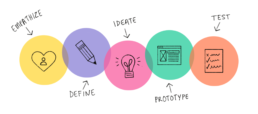The course.
I took an online course in 2018 called Mastering Design Thinking by MIT Sloan School – the program is “designed for team and individual who want to learn a proven, systematic approach to a new product design and development.” In simpler words, the program is about human-centered design that approaches problem-solving by understanding user needs.
The course included ten modules in 3 months online (approximately 6 to 8 hours per week).
Since the course happens online, attended students are literally from around the world. So the excellent experience I got thru the three months course was the international collaboration in a different time zone.
Design thinking is a human-centered approach to innovation that draws from the designer's toolkit to integrate the needs of people, the possibilities of technology, and the requirements for business success.
- Tim Brown, CEO of IDEO
Key takeaways.
What is Design Thinking?
Design thinking is a problem-solving approach that combines empathy, experimentation, and iteration to create innovative solutions. This process is used in various industries, including healthcare, to design products and services that meet users’ needs in an effective and user-friendly manner.
The Process
The design thinking process typically involves the following steps:
-
Empathize: This step consists of understanding users’ needs and experiences using products. This can be done through various methods, such as user research, customer feedback, and user interviews.
-
Define: Based on the insights gained from the empathy phase, the next step is defining the problem the product is trying to solve. This involves clearly articulating the needs of users and what they are looking for in a product solution.
-
Ideate: The ideation phase involves generating and testing potential solutions to the problem. This can include creating prototypes, experimenting with different designs, and exploring other technologies.
-
Prototype: In this step, the best ideas are selected and developed into prototypes. These prototypes are then tested with patients to gather feedback and make necessary changes.
-
Test: This step involves testing the prototypes with users to see how well they meet their needs and address their pain points. Feedback from users is used to refine the design and make any necessary improvements.
-
Implement: Once the prototypes have been tested and refined, the next step is to implement the product solution and make it available to users.

Design thinking has been widely adopted in various industries, including technology, healthcare, education, and more. It has proven to be a powerful tool for driving innovation and improving the lives of people around the world.
Benefits of Design Thinking in Telehealth
The design thinking process in telehealth has several benefits, including:
-
Improved User Experience: By understanding the needs and experiences of patients, telehealth services can be designed in a user-friendly manner that meets their needs.
-
Increased Innovation: The design thinking process encourages experimentation and iteration, leading to the development of innovative solutions to problems in telehealth.
-
Better Patient Outcomes: By focusing on the needs of patients, telehealth services can be designed to improve patient health outcomes.
-
Increased User Adoption: By designing telehealth services in a manner that is user-friendly and meets the needs of patients, user adoption is likely to increase.
Conclusion
The design thinking process in telehealth can help improve the user experience and patient health outcomes. By considering the needs of patients and applying a design thinking process to the development of telehealth services, healthcare providers can create compelling, user-friendly, and innovative solutions.
Related Posts
May 15, 2023
Designing Product Icons: Best Practices for a Lasting Impression
As I recall back to the first few years…
April 21, 2022
Consume, Respect and Contribute to the Design System
Design systems have become essential…

